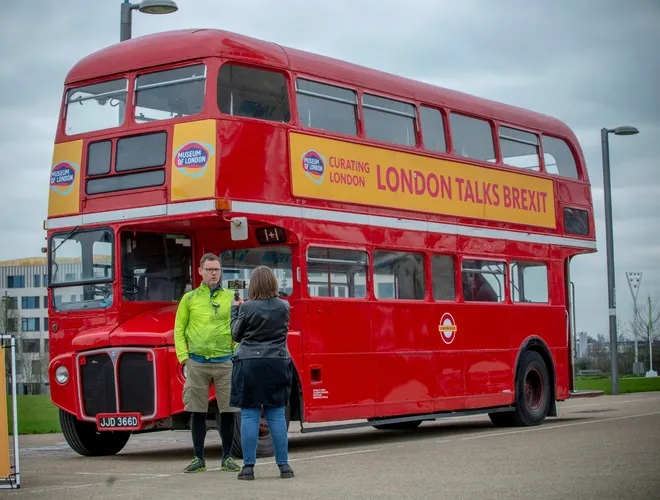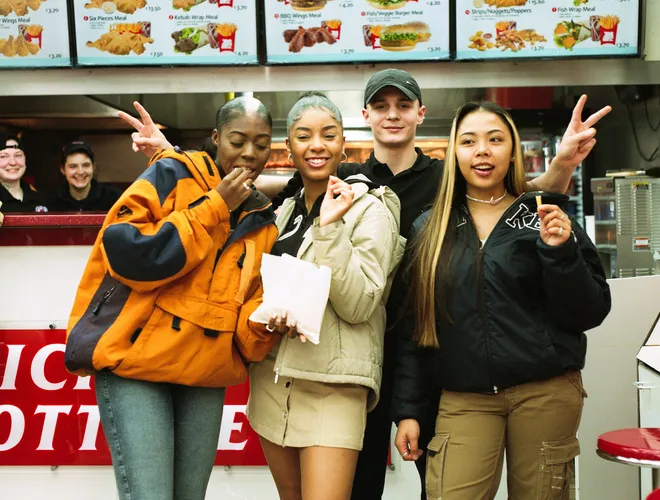Collecting local histories
Over two years, the Curating London programme engaged with residents to document diverse local stories and identities.
Over the first two years of the Curating London programme we took on a number of collecting projects targeted at specific areas across the city. The studies captured different aspects of London life, ranging from community and artist-led collecting to contemporary archaeology.
West London: Collecting Ends (2019–2020)
Throughout November and December 2019, a shop front in the iconic Portobello Arcade was transformed into a West London living room and live collecting space. This was curated by local young people in collaboration with FerArts, a non-profit arts organisation.
Trained on documenting their neighbourhoods, these young curators brought objects from their own homes as well as items bought at Portobello and Golborne markets to decorate the ‘living room’. Local residents, friends and family were then invited into the space to record their West London stories from the comfort of the Curating London sofa.
“It's good to see how you can be raised in the exact same household...but yet you have a completely different view”
Prime Isaac, West Side Stories
The project also gave small grants to three young people to create short documentaries on contemporary West London life from a youth perspective. These were:
- Beauty Treatment by Alia Hassan, Alyssa-Victoria Isip and Sam Campbell
- West Side Stories by Prime Isaac
- Living Rooms Project by Rajaa Bouchab and Azhar Benalhachmi
Collected items were then showcased in a week-long pop-up exhibition ‘Museum of (West) London’ at the FerArts studio.

A woman holds out piece of jewellery from Bangladesh.
East London: Weaving London’s Stories (2019–2020)
Weaving London’s Stories explored the relationship between dress and identity within the British-Bangladeshi community in Tower Hamlets. In partnership with the Osmani Trust, a local youth and community organisation, we worked with a group of young women (12–19 years), as well as members of the wider British-Bangladeshi community.
The project explored how different generations of women negotiate, resist and re-invent their relationship with traditional Bangladeshi clothing through a number of workshops and events. Additionally, we recorded several oral histories that give a snapshot of the lives of British-Bangladeshi women in the area, and also collected personal objects donated by the participants.
North London: Archaeology of Now (2019–2020)
In an increasingly busy and bounded city, our public parks are oases not only of ‘green space’ but also ‘free space’. The rubbish and objects left behind in London parks are testament to contemporary city life, and should these be preserved by a museum?
Over the course of a year, we worked with park users, neighbours, local schools and Furtherfield Gallery to collect discarded objects from the surface of the park. Finds ranged from cigarettes butts to condoms, and tea bags to needles. In summer, there were remains of barbeques, and in early January, the remnants of fireworks.
We analysed the ‘rubbish’ created today, using the same archaeological techniques as we would with 1,000-year-old debris. Questions that were addressed include: 'What we found? How they fit together? Where is it from, and what was around it?' This is called ‘archaeological context’. This meant each object was geotagged, photographed and a map made to identify its location – to compare and contrast findings.

Young activists at a screening of We The People at the Brixton Advocacy Academy.
South London: We The People (2018–2019)
What makes Brixton one of London’s most socially active neighbourhood?
We commissioned two local artists, Virginia Nimarkoh and Fan Sissoko, to work with Brixton-based The Advocacy Academy, a grassroots youth organisation, to create a short film exploring active citizenship.
Filmed over the summer of 2019, We The People explores themes of activism and community, past and present. The film, which is now part of the museum’s collection, follows six inspiring conversations between activists and grassroots organisers, who are making positive change at a local level.
The conversations take us on a journey across Brixton’s radical activist history: from the well-documented Brixton Uprising to the lesser-known histories of local queer activism and squatting. This includes the legacy of Olive Morris, a British community leader and activist in the feminist, Black and squatters’ rights campaigns of the 1970s.
The activists also reflect on the changing face of Brixton. As the neighbourhood attracts more affluent and less diverse communities, the spaces where people could come together, dream together and change the world together are threatened. What will remain of Brixton’s activist heritage in the face of gentrification and Brexit?
More Curating London projects
-

London Eats
How society, politics, economics and our disabilities influence the way Londoners connect with food
-

London's sports stories
A new and contemporary take on Londoners’ experiences of sport
-

Brexit Talks
Capturing Londoners’ views as the UK exited the EU through interviews and public events during 2019–2021
-

Curating London
The Curating London project collected objects and stories from diverse London communities




